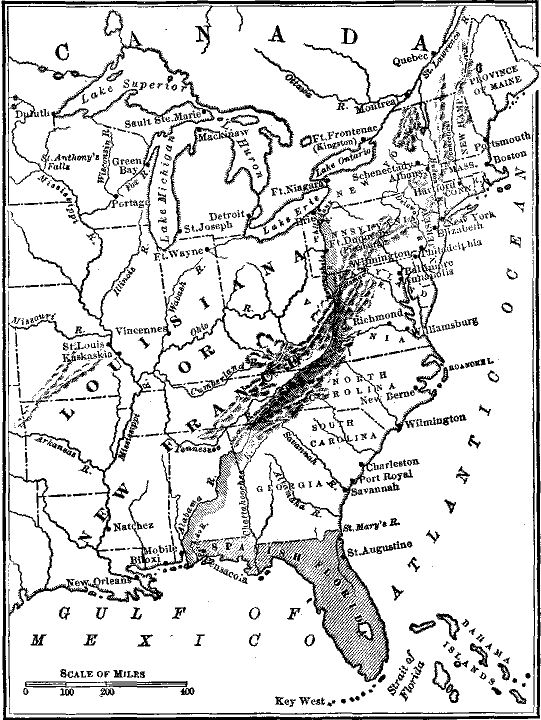Resource Center OLLibrary
|
110 |
|
[1673-1679 |
muddy torrent of the Missouri, past the mouth of the beautiful
Ohio. In about three weeks the explorers came to the spot where De
Soto (§ 21) had crossed the river more than a hundred years
before; then, pushing on, they reached the mouth of the Arkansas.
There some Indians told them that the tribes below were hostile to
strangers and that they had better return. Joliet and Marquette
took their advice, got into their canoes, and patiently paddled
their way back. Under the burning sun they battled for hundreds of
miles against the powerful current; it was indeed a tremendous
piece of uphill work.
At last they reached the mouth of the Illinois;
they worked their way up that river to an Indian village just
below Ottawa,

JOLIET AND MARQUETTE ENTERING THE MISSISSIPPI
and then made their way across to Lake Michigan. They had not
followed the Mississippi to the Gulf, as they intended, but who
will say that they had not made a good beginning?
131. La Salle reaches the Mouth of the
Mississippi. Six years later (1679) La Salle, the greatest of
the French explorers, a man of active brain and iron will, set out
from Canada to complete the work of Joliet and Marquette. On the
Niagara River, not far above the falls, he built the first sailing
vessel ever launched on the upper Great Lakes. In her he sailed to
Green Bay; then, sending the vessel back for supplies, he and his
companions went in canoes to the St. Joseph River,1
near the southeastern corner of Lake Michigan. (Map, p. 111.)
There they built a fort; then, crossing over to the head waters of
the Kankakee, a tributary of the Illinois, they descended that
river to the point where Peoria now stands. There they built a
second fort.
1 La Salle paddled from
Green Bay round to the St. Joseph River,
Michigan.
|
1679- ] |
|
111 |
Leaving a small garrison to hold this position, La Salle, near
the end of winter, went back on foot to Fort Frontenac (now

MAP SHOWING THE THIRTEEN
ENGLISH COLONIES AND
THE FRENCH
EXPLORATIONS AND
SETTLEMENTS IN THE
WEST
Kingston), on Lake Ontario, in eastern Canada. (Map, above.) He
made that journey of a thousand miles to get the supplies which he
needed for the exploration of the Mississippi.
|
112 |
|
[1681-1682 |
|
While he was gone, Father Hennepin,
a Catholic missionary in La Salle's expedition, set out
from |
|
1701-1718 ] |
|
113 |
Louis XIV, then the reigning sovereign of France. So the "Grand
Monarch," as he called himself, boasted that he held the heart of
the American continent.
132. The Founding of Mobile and New
Orleans. Many years later John Law, an enterprising Scotchman,
got permission from France to establish a colony in Louisiana. Law
expected to find rich mines of gold and silver, and every needy
and greedy Frenchman who could manage to scrape a few dollars
together wanted to buy stock in the company. The speculation
failed and made thousands beggars.
Still the undertaking had some permanent results
for good. A Frenchman named lberville had established a colony at
Mobile, on the Gulf of Mexico (1701). His brother, Bienville, was
appointed governor of Louisiana. It was hoped that he would send
shiploads of treasure back to France. He sent nothing of the sort,
but did far better, for he founded the city of New Orleans (1718).
The settlement consisted of a few log huts built around a fort; it
was destined to become the commercial metropolis of the great
Mississippi Valley, -- a valley capable of producing food enough
to feed all the civilized races of the globe.
133. The English hold the Atlantic coast, but
the French hold the interior of the country. Meanwhile, what
had the English colonists in the East done toward exploring and
occupying the country? Practically nothing. They simply continued
to hold their first settlement on the Atlantic coast; in other
words, the eastern edge of what is now the United States. The long
range of the Allegheny Mountains, rising like an immense wall,
seemed to hem them in.
But the French, starting from Canada, had
obtained a firm grip upon the interior of the country. They held
the Mississippi, and with it they claimed to hold the great
central West, extending from the Alleghenies to the base of the
Rocky Mountains.
What they held they meant to keep; La Salle
showed that when he built forts at the most important points of
his explorations, all the way down from the Great Lakes to the
Gulf of Mexico. (Map, p. 111.)
|
114 |
|
[1689-1697 |
 the
fort to explore the country. After many startling
adventures he finally reached a cataract on the upper
Mississippi, which he named the Falls of St. Anthony.
the
fort to explore the country. After many startling
adventures he finally reached a cataract on the upper
Mississippi, which he named the Falls of St. Anthony.



